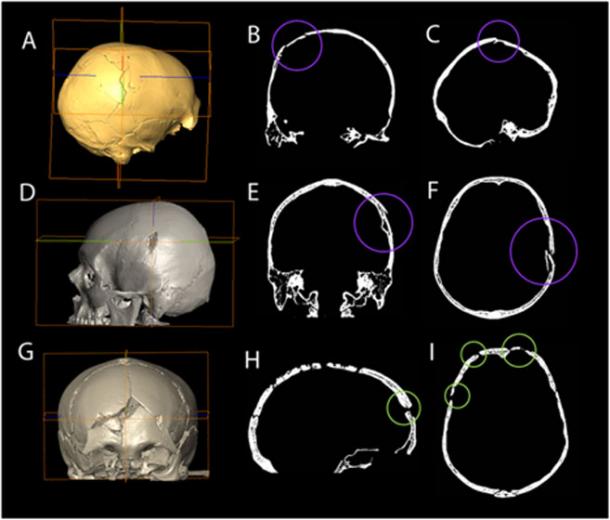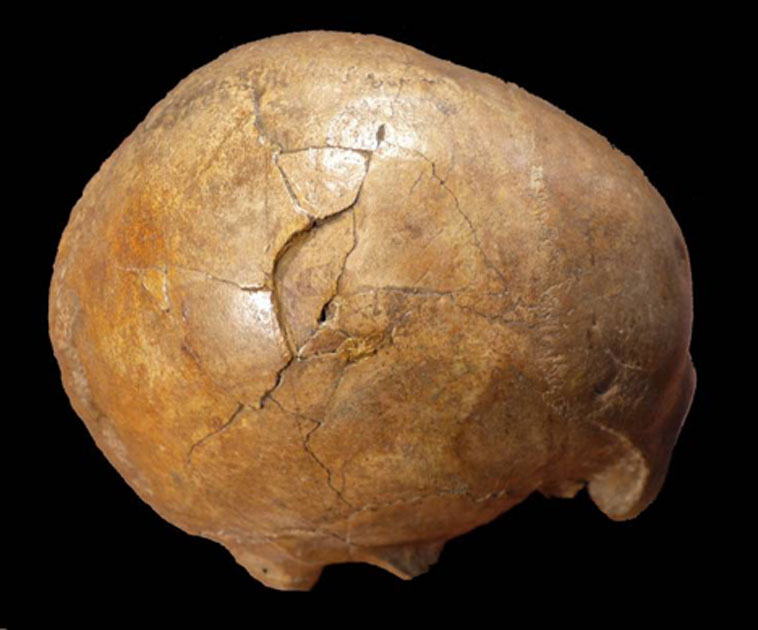Murder in the Paleolithic? Proof of Ancient Homicide Deduced By Forensic Archaeology
A paper published today has concluded that the 33,000 year old remains of a man excavated in a cave in South Transylvania are of the victim of a bloody and murderous attack. The cause of death was due to head trauma, with examination showing the man received two blows to the cranium in a frontal attack from this assailant. This subsequently led to his death.
The conclusions have been made solely based on the study of the skull, as the rest of the skeleton was never found. Found by miners in 1941, the skull is one of the oldest fossils of a modern human in Europe.
New analysis of the fossilized skull of the Upper Paleolithic using experimental simulations and forensic scientific methods is reported in a study published July 3, 2019 in the open-access journal PLOS ONE by an international team from Greece, Romania and Germany led by the Eberhard Karls Universität Tübingen, Germany.
The fossilized skull of a Paleolithic adult man, known as the Cioclovina calvaria, was originally uncovered in a cave in South Transylvania and is thought to be around 33,000 years old. Since its discovery, this fossil has been extensively studied.
- Forensic Facial Reconstruction: The Journey to Connect with our Ancestors
- Thanatographia Imago Mortis: The History of Futuristic Forensics
- Investigators use a Volunteer and Real Blood in Forensic Testing of the Shroud of Turin
Here, the authors reassessed trauma on the skull - specifically a large fracture on the right aspect of the cranium which has been disputed in the past - in order to evaluate whether this specific fracture occurred at the time of death or as a postmortem event.
The authors conducted experimental trauma simulations using twelve synthetic bone spheres, testing scenarios such as falls from various heights as well as single or double blows from rocks or bats. Along with these simulations, the authors inspected the fossil both visually and virtually using computed tomography technology.

A-C: Cioclovina, D-F: modern cranium with perimortem trauma (data obtained from the archives of the Department of Radiology, Heraklion University Hospital, Crete, Greece with permission), G-I: archaeological cranium with post-mortem damage (medieval specimen from the Ballumbie Collection, Department of Archaeology, University of Edinburgh, Scotland). Note the plastic deformation of the perimortem fractures in the 2-dimensional figures (B, C, E and F) compared to the sharp edges at right angles to the bone surface indicating post-mortem damage (H and I).( Kranoti et al / Plos One)
The authors found there were actually two injuries at or near the time of death: a linear fracture at the base of the skull, followed by a depressed fracture on the right side of the cranial vault.
The simulations showed that these fractures strongly resemble the pattern of injury resulting from consecutive blows with a bat-like object; the positioning suggests the blow resulting in the depressed fracture came from a face-to-face confrontation, possibly with the bat in the perpetrator's left hand. The researchers' analysis indicates that the two injuries were not the result of accidental injury, post-mortem damage, or a fall alone.

Mechanism of blunt force trauma on the vault A) Low velocity impact on the skull causing fracture formation at the impact point due to initial inbending of the cranial vault with peripheral outbending; inward displacement of the bony fragment due to plastic deformation; small fragments remaining in place suggest that the impact took place while soft tissue was present. B) Radiating fractures in the area of outbending which start at one or more points distant to the impact site, progressing both towards to the impact point and in the opposite direction (away from it); C) The radiating fractures stop when they meet the sutures (e.g. R1). D) Formation of concentric fractures forming perpendicular to the radiating fractures. Image credit: Iakovos Ouranos / Plos One
While the fractures would have been fatal, only the fossilized skull has been found, so it's possible that bodily injuries leading to death might also have been sustained. Regardless, the authors state that the forensic evidence described in this study points to an intentionally-caused violent death, suggesting that homicide was practiced by early humans during the Upper Paleolithic.
The authors add: "The Upper Paleolithic was a time of increasing cultural complexity and technological sophistication. Our work shows that violent interpersonal behaviour and murder was also part of the behavioural repertoire of these early modern Europeans."
Top image: Right lateral view of the Cioclovina calvaria exhibiting a large depressed fracture. Source: Kranoti et al / Plos One
The article, originally titled, ‘Murder in the Paleolithic? Evidence of violence behind human skull remains’ was originally published on Science Daily.
Source: PLOS. "Murder in the Paleolithic? Evidence of violence behind human skull remains." ScienceDaily. ScienceDaily, 3 July 2019. <www.sciencedaily.com/releases/2019/07/190703150508.htm>.
References
Elena F. Kranioti, Dan Grigorescu, Katerina Harvati. State of the art forensic techniques reveal evidence of interpersonal violence ca. 30,000 years ago. PLOS ONE, 2019; 14 (7): e0216718 DOI: 10.1371/journal.pone.0216718




















Comments
As a former student of Anthropology, it has always puzzled me how assertions are made about the past from so little physical evidence. Instead of being infatic about the past from a single bit information regarding an archeological find, why aren't all possible scenarios presented? Murder is not the only possibility here. This is similar to when something from the past is discovered and an archeologist doesn't know exactly what its purpose was, so they claim that it must have been used ceremonial purposes or worship of the gods. Are archeologists psychic or something? In this particular situation with the evidence of how skull was crushed, there are two other scenarios that are just as plausible due to the lack of extenuating evidence. 1) A mercy killing due to insufferable injuries sustained from a hunting expedition, like being gourd by a giant cow (auroch/bos primigenius). Or, irreparable injuries from a number of other situations. 2) The fractures to this skull could have been a result of combat with a rival tribe or in-fighting for tribal leadership. The point is: the only thing this bit of evidence can prove, without other supporting forensic evidence, is that the 33,000 year old individual sustained fatal injuries to the head caused by blunt force. Why is it that archeologists feel that they have the psychic ability to extrapolate beyond the physical evidence and make up some story that would be thrown out of a courtroom before the trial begins? What superhuman ability do they have to make up these stories? Why don't they simply present the evidence and then admit beyond that, they simply do not know what happened or in other cases how an artifact/structure was used? Present all possible scenarios, unless of course, there is supporting evidence to make claims to a specific theory. Murder, combat...sure, we know humans can be evil; but we can also be merciful. I like promoting the latter of the two! Which dog do you feed?
Loki 32801